First: The resolution of a more accurate cosmology can probably be achieved by comparing the large-scale structures of galaxies to that of standard volcanic magma. Proposal: quantum 'gas' bubbles produced what only seem like pockets of 'negative gravity' and made the gigantic cosmic 'voids'. Bubbles .. plural.
As dimensions unfolded into existence several pockets of quantum gas increased and blew outwardly in an event similar to liquid-to-gas phase transition. Gravity then acted like a viscous fluidic medium where gravitic 'surface tension' bound the galaxies into clumps, streamers, and threads surounding huge trans-galactic 'voids'. Graphic images of both events will be shown comparing the phenomena.
Also: a casual challenge is made to the modern cosmic cartographers. If the images we make of the cosmos constructed of current patterns of light coming to planet earth truly represent a 'looking into the past', then in point of fact, the universe doesn't really look like the patterns we currently see. Every star, speck and galaxy image would have to be re-adjusted for speeds, directions and momen- tums ... forward in time and space (increasingly adjusted the further away they are determined to be) ... in order to re-construct a more accurate view of the universe as it would exist in an essential "now".
~ ~ ~ ~ ~ ~ ~ ~ ~ ~ ~ ~ ~ ~
1.1. Current Cosmology Gaps. A Solution by Scaling.
Let me get right to the point. All cosmologies as of this moment beg accuracy. Not on the small-scale end of things .. aspects having to do with the primal constructa of our material universe. Nor with important particulars .. including the massive scaled cosmological structures on the galactic sized scales of things.
The issue I take here is with the diagramatic representations of what our universe 'really' looks like based on all the information gathered about what's out there ... on the grandest scale of things.
It seems, some astronomers are informing us, that the universe is a collection of great galactic nodules, strung together with filamentous strands of galaxies in between and interrupted in the midst of all this vastness by absolutely huge bubbles where there is essentially little or nothing . . . the void-est of voids.
That image of the universe is very appealing to me. But I am as conservative in my paradigm of existence as I am an innovator in how to consider the organization and behaviors of the universe. Which means that the kinds of explanations which have been brought to bear by mainstream scientists .. including the very highly regarded possibility that an undetected force exists which is essentially 'repulsive' .. in comparison to Gravity's 'attraction' vectors... is viewed with a great bit of skepticism by me. It is conjectured by some that such a force may have existed only in the early universe and the cosmic bubbles are remnants pointing to the short but effective duration-life of this 'Anti-gravity' force.
I don't think that is the scenario. I suggest that the solution is more subtle, albeit simpler, and requires no 'new' force to exist than the ones currently known.
While watching several television programs this past year on Volcanos, some of the images jarred my recognition and I suddenly realized that I had seen them before in an astronomy context .. the large galactic structures discovered during the past 10-15 years in studies of galaxy distributions based on doppler red-shift patterns. And in fact, the similarity of contexts, considered in coordination with my model of Dimensional Architecture which treats Gravity as a product of interacting Temporal Dimensions--and therefore enabling it to be a fluidic medium--pointed to possible mechanisms that can account for the cosmic empty-spaces.
Beginning with studies reported in 1988 ["Extragalactic Distance Scale"], there are about a dozen or more projects and research programs worldwide involved with mapping the cosmos at that scale. Several Internet websites (extant Summer 2000) will be listed at the end of the paper. Many diagrams and graphics have been brought here from those sites, for comparison sake.
Several text descriptions go like these samples:
==================================================================
University of Arizona, Course description, December 1997
"(note that galaxies form a soap bubble-like or "foamy" distribution in space with galaxies lying along the surfaces of the bubbles and nothing in the centers of the bubbles; these nearly empty regions are observed and are called "voids")"
Professor Anthony Fairall June 1998
"..nebulae are distributed in a very non-uniform or non-random fashion. Lines and filaments of galaxies surround empty voids. This is now known to be the true texture of the cosmos.."
"Since the early 1980s, I have used my own redshifts, and those that became available from other sources, to map the distribution of galaxies, chiefly in the southern sky. As such I have been privileged to see the texture of the universe, the labyrinth of filaments, sheets and voids, emerge. Over the years, more and more data has been added - and as it has, so the large-scale structures have been revealed - see Figure 4. The experience has been like seeing a photograph develop in a tank. First crude concentrations of galaxies appeared, later to be refined into complex great walls and a labyrinth of interconnected structures.".
"The discovery of the cosmic texture is all the more remarkable because it was so unexpected. Like the early criticism of Einasto's work, it seemed to run contrary to common sense. The galaxies are, on a cosmic scale, effectively particles - and should no more form into foamlike formations than the molecules of air inside this room. The finding has brought about a revolution in cosmology. The understanding of how such large structures formed - and what they represented - has been an enormous challenge.
Conventional wisdom has it that, on the largest scale, the only significant physical force is gravity. Had the early universe been homogeneous, gravity could not have worked. But if there were places where the concentration of mass was just slightly higher than average, then they would have gained a gravitational advantage over their surroundings - and that advantage would have very gradually pulled in more and more material, so that the concentration grew stronger and stronger. Similarly, places where the concentration of mass was just slightly lower than average would have had a gravitational disadvantage - they would have lost out as material was further pulled out from them. This then is probably the manner in which large-scale structures grew from slight overdensities and voids grew from slight underdensities.
But if this is so, the pattern of the large-scale structures predated their formation, and the texture of the structures tells us something very fundamental about the universe. Where did the seeding pattern of slight over- and under-densities come from?
Currently, a theory known as “inflation” provides a possible answer. It holds that there was an incredibly brief era in the very early universe when enormous expansion took place - so much so that things on a microscopic quantum scale were blown up out of all proportion. In this way, the so called quantum fluctuations, that existed on an absolutely microscopic scale, could have been grossly enlarged to provide the seedings for the labyrinth of large-scale structures. This is one explanation, which may well be correct, but inflation which has been in vogue in cosmological research since 1980 has recently come in for some criticism." ...
... "The new supernova data now indicate that a positive (repulsive) cosmological constant may yet be real - and we may be forced to face its existence.
But what is the cosmological constant? It is a sort of anti-gravity. It repels rather than attracts. In fact its symmetry with gravity may be philosophically reassuring, as the electromagnetic force works with both attraction and repulsion. " ..
.. " We do not have as yet any understanding of what this cosmological force is. " ... "It would complement gravity in explaining how some of the finer details came about. It would explain the shortcomings of the computer simulations that work with gravity alone. It could too provide the driving mechanism for the expansion of the universe."
Steven Landy, Scientific American, June 1999
".. for cosmologists, those who study nature on its very largest scales, a galaxy is merely the basic unit of matter. Billions of them fill the observable universe. They congregate into clusters three million or more light-years across, which in turn constitute progressively larger assemblages. On all scales observed thus far by astronomers, galaxies appear to cluster and form intricate structures-- presumably through physical processes that were dominant during the early expansion of the universe and later through gravitational interactions.
Yet there is a paradox. The clumpiness of galaxies runs contrary to one of the essential tenets of modern cosmology: the cosmological principle, the concept that the universe overall is homogeneous and isotropic, that it has no preferred place or orientation.
"Cosmo-cartographers discovered that on scales of up to 100 million light-years, galaxies are distributed as a fractal with a dimension of between one and two. ... Subsequent surveys, however, indicated that on scales of hundreds of millions of light-years, the fractal nature broke down. " ...
... "Looking at the maps produced by the survey, the eye is struck by the sense that the galaxies are not randomly distributed but instead tend to bunch together [see illustration: White and Pink Noise]. Yet one must be careful of visual impressions. Our brains often seek patterns where none exist. In this case, however, statistical techniques bear out the existence of clustering." ...
... "A Great Number of Great Walls "...
... "sharp boundaries, filaments and voids in the galaxy maps. The largest are almost three billion light-years across, several times the size of the Great Wall". ...
..."Several hypotheses have emerged, although none can yet be reconciled with all the data. The first is a hot dark matter scenario wherein the universe is dominated by light, fast-moving particles such as neutrinos. The result would be a top-down progression in structure formation starting on large scales. Unfortunately, this theory has the side effect of washing out structure on small scales, so it fails to account for the small-scale galaxy clustering.
A second hypothesis posits that the universe is less dense than cosmologists suppose. Most of this decrease in density comes at the expense of exotic dark matter. Ordinary particles such as protons and electrons thus have a proportionately greater influence. They would have constituted a viscous fluid in the early universe. Before the universe was cool enough for the protons and electrons to combine and form atoms, sound waves reverberated through this fluid. When the protons and electrons recombined, the acoustic waves gave a boost to the gravitational collapse on certain scales. Intriguingly, an underdense universe would also resolve other cosmological conundrums [see "Inflation in a Low-Density Universe," by Martin A. Bucher and David N. Spergel; Scientific American, January].
A third hypothesis points out that 600 million light-years is roughly the horizon distance at the time when the average density of matter in the universe overtook that of radiation. Such a profound change would presumably have affected the power spectrum somehow. Whatever the final explanation, it may be that astronomers are detecting the largest unique length scale associated with any physical process in nature."
====================================================================
Now. Here are some of the composite images of the massive large
scale forms, including
projections done using fractal methods, and non-fractal supercomputer algorithms.
 |
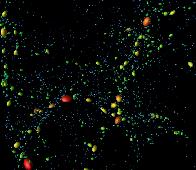 |
 |
 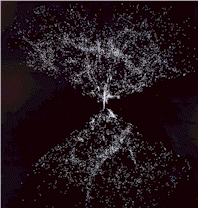 |
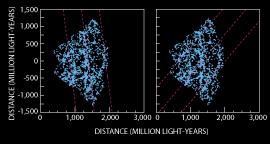

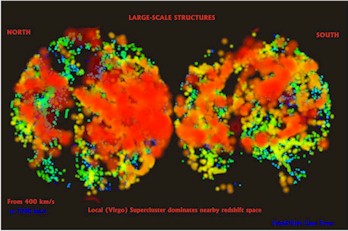
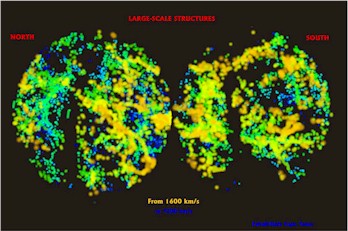

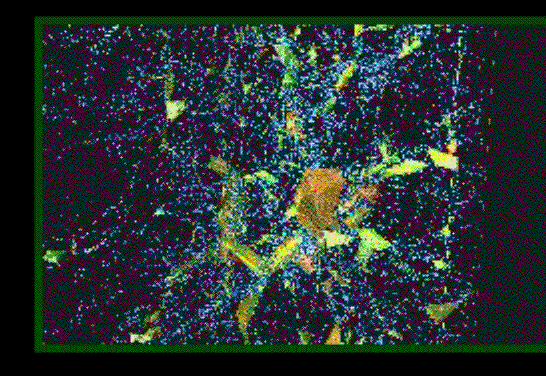

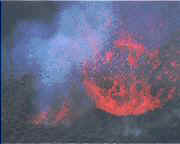
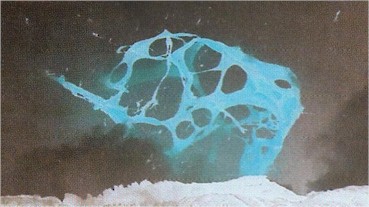

 1.2.
Quantum Topological Vulcanism
1.2.
Quantum Topological Vulcanism